Zoekresultaten voor "bundle OR raspberry OR pi OR zero OR w OR raspberry OR pi OR and OR pico OR special"
-
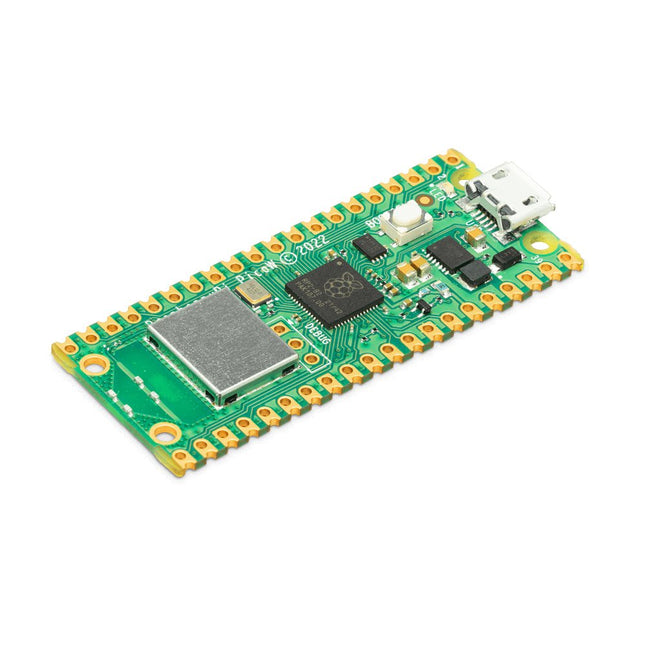
Raspberry Pi Foundation Raspberry Pi Pico W
De Raspberry Pi Pico W is een microcontroller board gebaseerd op de Raspberry Pi RP2040 microcontroller chip. De RP2040-microcontrollerchip ('Raspberry Silicon') heeft een dual-core ARM Cortex-M0+ processor (133 MHz), 256 KB RAM, 30 GPIO-pinnen, en nog vele andere interface opties. Daarnaast is er 2 MB on-board QSPI-flashgeheugen voor code- en gegevensopslag. De Raspberry Pi Pico W is ontworpen als een goedkoop maar flexibel ontwikkelingsplatform voor de RP2040, met een 2,4 GHz draadloze interface met de Infineon CYW43439. De draadloze interface is via SPI aangesloten op de RP2040. Kenmerken van de Pico W RP2040 microcontroller met 2 MB flashgeheugen On-board single-band 2,4 GHz draadloze interfaces (802.11n) Micro USB B poort voor voeding en data (en voor het herprogrammeren van de flash) 40 pin 21 x 51 mm 'DIP' stijl 1 mm dikke PCB met 0,1' through-hole pinnen met ook gegroefde gaten. Beschikt over 26 multifunctionele 3,3 V I/O voor algemeen gebruik (GPIO) 23 GPIO zijn alleen digitaal, en 3 GPIO die ook geschikt zijn voor ADC Kan als opbouw-module worden gemonteerd 3-pins ARM serial wire debug (SWD) poort Eenvoudige maar zeer flexibele mogelijkheden voor de voeding: Verschillende opties om het apparaat eenvoudig van stroom te voorzien via micro-USB, externe voedingen of batterijen Hoge kwaliteit, lage kosten, hoge beschikbaarheid Uitgebreide SDK, voorbeeldsoftware en documentatie Kenmerken van de RP2040 microcontroller Dual-core cortex M0+ tot maximaal 133 MHz On-chip PLL maakt variabele core-frequentie mogelijk 264 kByte multi-bank SRAM met hoge prestaties Externe Quad-SPI Flash met eXecute In Place (XIP) en 16 kByte on-chip cache Hoogwaardige full-crossbar bus architecture Ingebouwde USB1.1 (device of host) 30 multifunctionele algemene I/O (vier kunnen worden gebruikt voor ADC) 1,8-3,3 V I/O-spanning 12-bits 500 ksps analoog naar digitaal converter (ADC) Diverse digitale randapparatuur 2x UART, 2x I²C, 2x SPI, 16x PWM kanalen 1x timer met 4 alarmen, 1x real time clock 2x programmeerbare I/O (PIO) blokken, 8 state machines in totaal Flexibele, door de gebruiker programmeerbare high-speed I/O Kan interfaces zoals SD-kaart en VGA emuleren Note: De Raspberry Pi Pico W I/O-spanning is 3,3 V. Downloads Datasheet Specifications of 3-pin Debug Connector
€ 7,95
Leden identiek
-
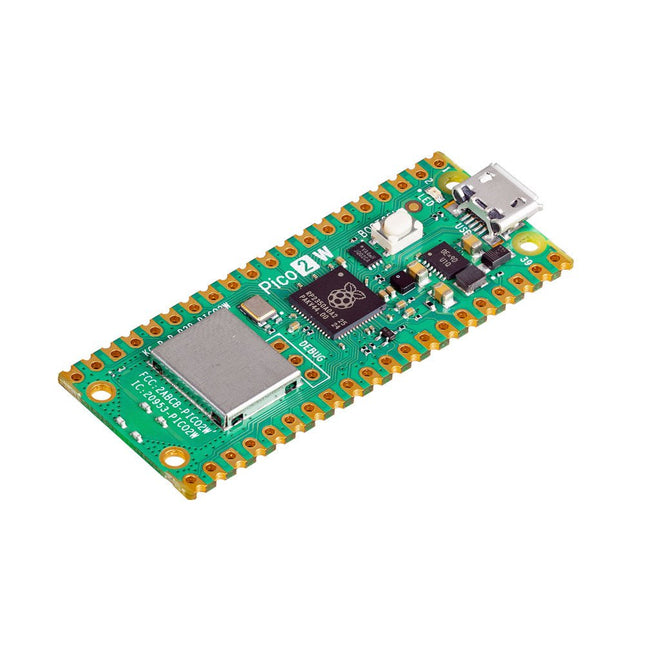
Raspberry Pi Foundation Raspberry Pi Pico 2 W
De Raspberry Pi Pico 2 W is een microcontrollerbord gebaseerd op de RP2350 met 2,4 GHz 802.11n wireless LAN en Bluetooth 5.2. Het geeft u nog meer flexibiliteit in uw IoT- of slimme productontwerpen en breidt de mogelijkheden voor uw projecten uit. De RP2350 biedt een uitgebreide beveiligingsarchitectuur gebouwd rond Arm TrustZone voor Cortex-M. Het bevat ondertekend opstarten, 8 KB antifuse OTP voor sleutelopslag, SHA-256-versnelling, een hardware TRNG en snelle glitch-detectoren. Dankzij de unieke dual-core en dual-architectuurmogelijkheden van de RP2350 kunnen gebruikers kiezen tussen een paar industriestandaard Arm Cortex-M33-kernen en een paar open-hardware Hazard3 RISC-V-kernen. Programmeerbaar in C/C++ en Python, en ondersteund door gedetailleerde documentatie, is de Raspberry Pi Pico 2 W het ideale microcontrollerbord voor zowel liefhebbers als professionele ontwikkelaars. Specificaties CPU Dual Arm Cortex-M33 of dubbele RISC-V Hazard3-processors @ 150 MHz Wireless Geïntegreerde Infineon CYW43439 single-band 2,4 GHz 802.11n wireless LAN en Bluetooth 5.2 Geheugen 520 KB SRAM op de chip; 4 MB ingebouwde QSPI-flitser Interfaces 26 multifunctionele GPIO-pinnen, waaronder 4 die kunnen worden gebruikt voor AD Randapparatuur 2x UART 2x SPI-controllers 2x I²C-controllers 24x PWM-kanalen 1x USB 1.1-controller en PHY, met host- en apparaatondersteuning 12x PIO-statusmachines Ingangsvermogen 1,8-5,5 V DC Afmetingen 21 x 51 mm Downloads Datasheet Pinout Schematic
€ 7,95
Leden identiek
-
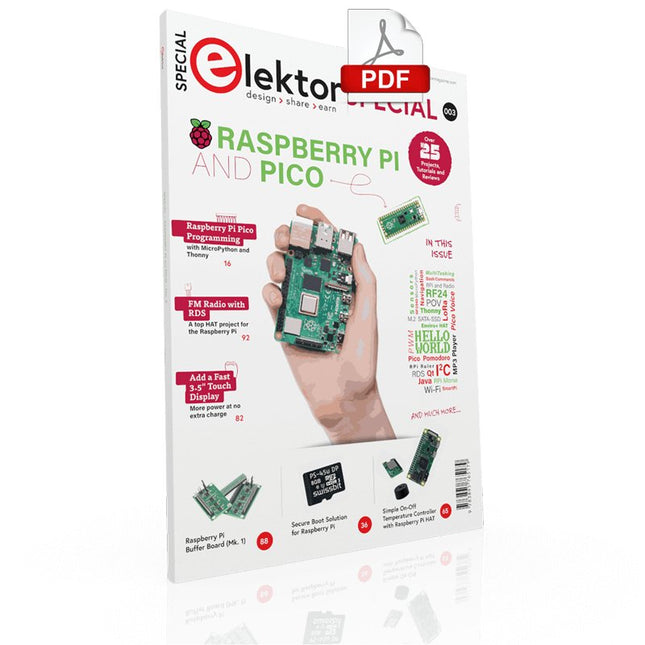
Elektor Digital Elektor Special: Raspberry Pi and Pico (PDF)
Contents Projects PicoVoiceVoice alienation and sound effects with the Raspberry Pi Pico Navigation with Vibration Feedback POV Display Pulse Width Modulation (PWM) with the Raspberry Pi Pico Wi-Fi with the Raspberry Pi Pico 'Hello World' from the Raspberry Pi Pico and RP2040A look at the Raspberry Pi Foundation’s first microcontroller Simple On-Off Temperature Controller with Raspberry Pi HAT Multitasking with the Raspberry PiShowcase: a traffic lights controller The Raspberry Pi Ruler GadgetFun with a time-of-flight sensor Raspberry Pi Buffer Board (Mk. 1)Never blow up the I/O again FM radio with RDSA top HAT project for the Raspberry Pi LoRa with the Raspberry Pi PicoFun with MicroPython! Tutorials Qt for the Raspberry Pi Raspberry Pi Pico Programmingwith MicroPython and Thonny Raspberry Pi Full StackRPi and RF24 at the heart of a sensor network Raspberry Pi Bash Command Cheat Sheet Community Java on the Raspberry PiAn interview with Frank Delporte Reviews Introducing the New Raspberry Pi Pico W, H, and WH Secure Boot Solution for Raspberry PiRetrofit security at a reasonable price Review: SmartPi – Smart Meter Extension for Raspberry Pi Review: The Enviro+ Raspberry Pi HATMeasuring environmental data with Raspberry Pi and the HAT Enviro+ Review: Meet the Raspberry Pi 4All new but still good? Raspberry Pi Gets a Fast 3.5' Touch DisplayMore power at no extra charge Book Launch: Raspberry Pi for Radio Amateurs
€ 11,95
Leden € 10,76
-

Elektor Publishing Raspberry Pi Pico W (Book)
Program, build, and master 60+ projects with the Wireless RP2040 The Raspberry Pi Pico and Pico W are based on the fast, efficient, and low-cost dual-core ARM Cortex M0+ RP2040 microcontroller chip running at up to 133 MHz and sporting 264 KB of SRAM and 2 MB of Flash memory. Besides spacious memory, the Pico and Pico W offer many GPIO pins, and popular peripheral interface modules like ADC, SPI, I²C, UART, PWM, timing modules, a hardware debug interface, and an internal temperature sensor. The Raspberry Pi Pico W additionally includes an on-board Infineon CYW43439 Bluetooth and Wi-Fi chipset. At the time of writing this book, the Bluetooth firmware was not yet available. Wi-Fi is however fully supported at 2.4 GHz using the 802.11b/g/n protocols. This book is an introduction to using the Raspberry Pi Pico W in conjunction with the MicroPython programming language. The Thonny development environment (IDE) is used in all of the 60+ working and tested projects covering the following topics: Installing the MicroPython on Raspberry Pi Pico using a Raspberry Pi or a PC Timer interrupts and external interrupts Analogue-to-digital converter (ADC) projects Using the internal temperature sensor and external sensor chips Using the internal temperature sensor and external temperature sensor chips Datalogging projects PWM, UART, I²C, and SPI projects Using Bluetooth, WiFi, and apps to communicate with smartphones Digital-to-analogue converter (DAC) projects All projects are tried & tested. They can be implemented on both the Raspberry Pi Pico and Raspberry Pi Pico W, although the Wi-Fi-based subjects will run on the Pico W only. Basic programming and electronics experience are required to follow the projects. Brief descriptions, block diagrams, detailed circuit diagrams, and full MicroPython program listings are given for all projects.
€ 44,95
Leden identiek
-
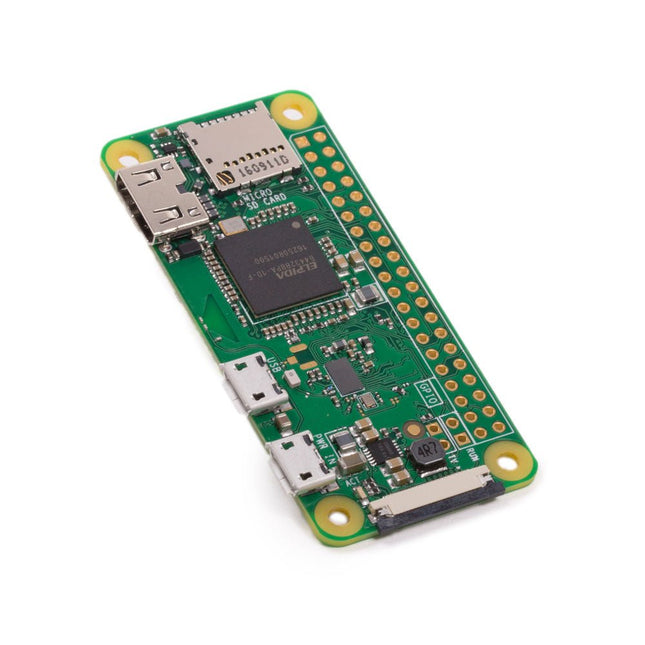
Raspberry Pi Foundation Raspberry Pi Zero W
De Raspberry Pi Zero W is de nieuwste telg van de Raspberry Pi Zero-familie. De Raspberry Pi Zero W heeft alle functionaliteit van de originele Raspberry Pi Zero, maar wordt geleverd met toegevoegde connectiviteit bestaande uit: 802.11 b/g/n WLAN Bluetooth 4.1 Bluetooth Low Energy (BLE) Overige kenmerken 1 GHz, single-core CPU 512 MB RAM Mini HDMI en USB On-The-Go poorten Micro-USB voeding HAT-compatibele 40-pins header Composiet video en reset headers CSI-camera-aansluiting Downloads Mechanische tekening Schema's
€ 17,95
Leden identiek
-
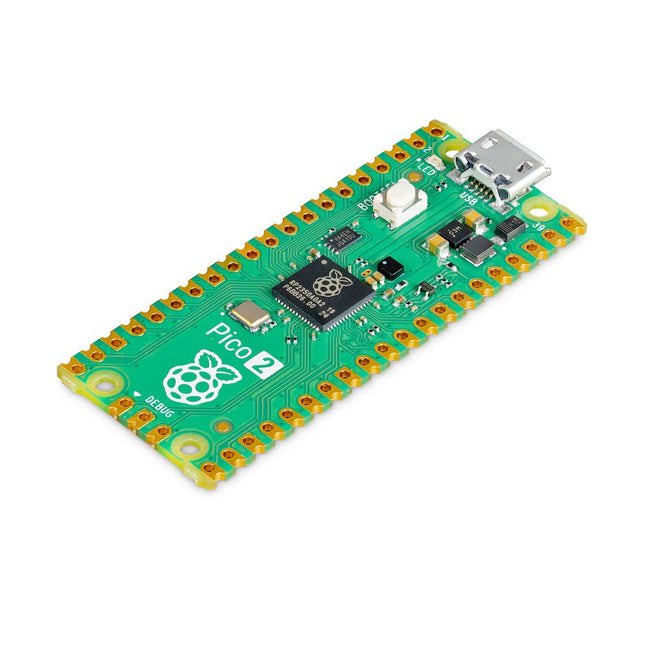
Raspberry Pi Foundation Raspberry Pi Pico 2
De Raspberry Pi Pico 2 is een nieuw microcontrollerbord van de Raspberry Pi Foundation, gebaseerd op de RP2350. Het beschikt over een hogere kloksnelheid, het dubbele van de on-chip SRAM, het dubbele van het ingebouwde flashgeheugen, krachtigere Arm-cores, optionele RISC-V-cores, nieuwe beveiligingsfuncties en verbeterde interfacemogelijkheden. De Raspberry Pi Pico 2 biedt een aanzienlijke verbetering in prestaties en functies, terwijl de hardware- en softwarecompatibiliteit met eerdere leden van de Raspberry Pi Pico-serie behouden blijft. De RP2350 biedt een uitgebreide beveiligingsarchitectuur gebouwd rond Arm TrustZone voor Cortex-M. Het bevat ondertekend opstarten, 8 KB antifuse OTP voor sleutelopslag, SHA-256-versnelling, een hardware TRNG en snelle glitch-detectoren. Dankzij de unieke dual-core en dual-architectuurmogelijkheden van de RP2350 kunnen gebruikers kiezen tussen een paar industriestandaard Arm Cortex-M33-kernen en een paar open-hardware Hazard3 RISC-V-kernen. Programmeerbaar in C/C++ en Python, en ondersteund door gedetailleerde documentatie, is de Raspberry Pi Pico 2 het ideale microcontrollerbord voor zowel liefhebbers als professionele ontwikkelaars. Specificaties CPU Dual Arm Cortex-M33 of dubbele RISC-V Hazard3-processors @ 150 MHz Geheugen 520 KB SRAM op de chip; 4 MB ingebouwde QSPI-flitser Interfaces 26 multifunctionele GPIO-pinnen, waaronder 4 die kunnen worden gebruikt voor AD Randapparatuur 2x UART 2x SPI-controllers 2x I²C-controllers 24x PWM-kanalen 1x USB 1.1-controller en PHY, met host- en apparaatondersteuning 12x PIO-statusmachines Ingangsvermogen 1,8-5,5 V DC Afmetingen 21 x 51 mm Downloads Datasheet (Pico 2) Datasheet (RP2350)
€ 5,95
Leden identiek
-
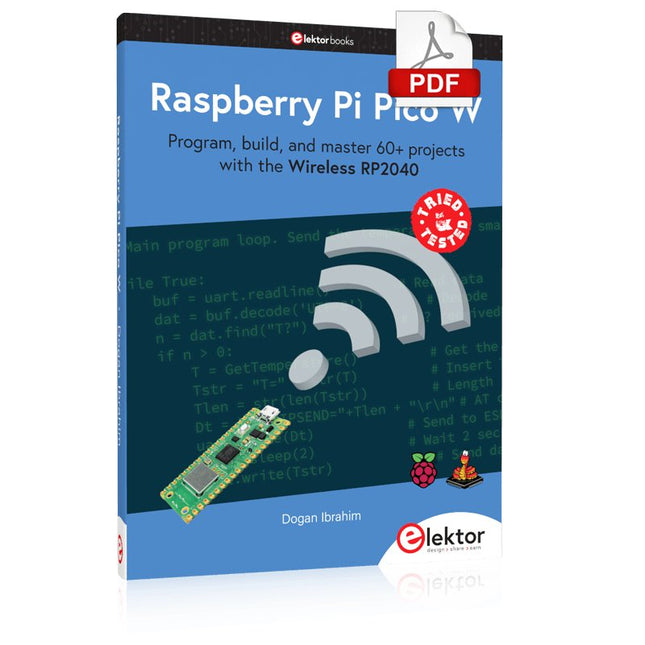
Elektor Digital Raspberry Pi Pico W (E-book)
Program, build, and master 60+ projects with the Wireless RP2040 The Raspberry Pi Pico and Pico W are based on the fast, efficient, and low-cost dual-core ARM Cortex M0+ RP2040 microcontroller chip running at up to 133 MHz and sporting 264 KB of SRAM and 2 MB of Flash memory. Besides spacious memory, the Pico and Pico W offer many GPIO pins, and popular peripheral interface modules like ADC, SPI, I²C, UART, PWM, timing modules, a hardware debug interface, and an internal temperature sensor. The Raspberry Pi Pico W additionally includes an on-board Infineon CYW43439 Bluetooth and Wi-Fi chipset. At the time of writing this book, the Bluetooth firmware was not yet available. Wi-Fi is however fully supported at 2.4 GHz using the 802.11b/g/n protocols. This book is an introduction to using the Raspberry Pi Pico W in conjunction with the MicroPython programming language. The Thonny development environment (IDE) is used in all of the 60+ working and tested projects covering the following topics: Installing the MicroPython on Raspberry Pi Pico using a Raspberry Pi or a PC Timer interrupts and external interrupts Analogue-to-digital converter (ADC) projects Using the internal temperature sensor and external sensor chips Using the internal temperature sensor and external temperature sensor chips Datalogging projects PWM, UART, I²C, and SPI projects Using Bluetooth, WiFi, and apps to communicate with smartphones Digital-to-analogue converter (DAC) projects All projects are tried & tested. They can be implemented on both the Raspberry Pi Pico and Raspberry Pi Pico W, although the Wi-Fi-based subjects will run on the Pico W only. Basic programming and electronics experience are required to follow the projects. Brief descriptions, block diagrams, detailed circuit diagrams, and full MicroPython program listings are given for all projects.
€ 34,95
Leden € 27,96
-
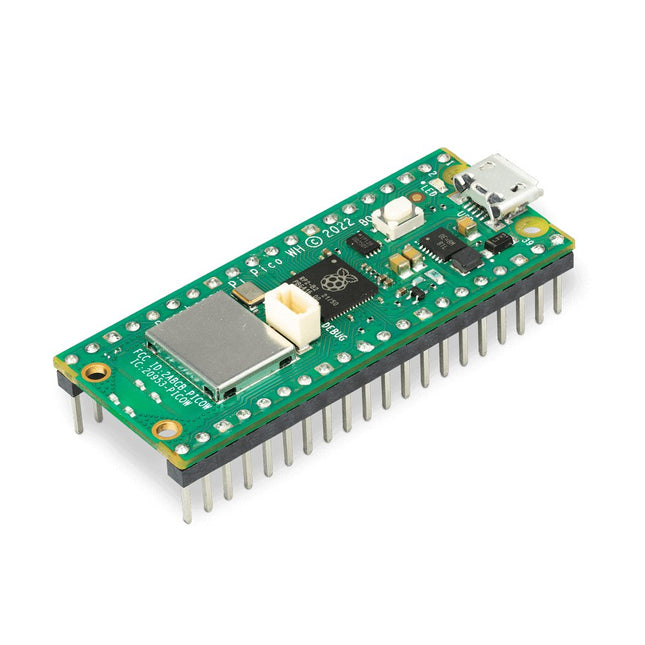
Raspberry Pi Foundation Raspberry Pi Pico WH
De Raspberry Pi Pico WH is een microcontroller board gebaseerd op de Raspberry Pi RP2040 microcontroller chip. De RP2040 microcontroller ('Raspberry Silicon') maakt gebruik van een dual-core ARM Cortex-M0 + -processor (133 MHz), 256 KB RAM, 30 GPIO-pinnen en vele andere interface opties. Daarnaast heeft hij 2 MB on-board QSPI flash geheugen voor het opslaan van code en data. De Raspberry Pi Pico WH is ontworpen als een goedkoop maar flexibel ontwikkelplatform voor de RP2040, met een 2.4 GHz draadloze interface die gebruik maakt van een Infineon CYW43439. De draadloze interface is via SPI verbonden met de RP2040. Kenmerken van de Pico WH RP2040 microcontroller met 2 MB flash geheugen On-board single-band 2,4 GHz draadloze interfaces (802.11n) Micro-USB-B poort voor voeding en data (en voor het herprogrammeren van de flash) 40 pins 21 x 51 mm 'DIP' stijl 1 mm dikke PCB met 0,1' through-hole pinnen, met ook castellations aan de rand Beschikt over 26 multifunctionele 3,3 V general purpose I/O (GPIO) poorten 23 hiervan zijn alleen digitaal, waarvan er 3 ook geschikt zijn voor ADC Kan als module op andere bordjes bevestigd worden 3-pins ARM serial wire debug (SWD) poort Eenvoudige maar zeer flexibele mogelijkheden voor de voeding Verschillende opties om het apparaat eenvoudig te voeden via micro-USB, externe voedingen of accu’s Hoge kwaliteit, lage kosten, hoge beschikbaarheid Uitgebreide SDK, software voorbeelden en documentatie Voorgemonteerde headers en een 3-pins debug connector Kenmerken van de RP2040 microcontroller Dual-core cortex M0+ tot 133 MHz On-chip PLL maakt variabele clocking van de core mogelijk 264 kByte multi-bank high performance SRAM Externe Quad-SPI Flash met eXecute In Place (XIP) en 16 kByte on-chip cache Hoogwaardige full-crossbar bus fabric On-board USB1.1 (randapparaat of host) 30 multifunctionele general purpose I/O-poorten (4 kunnen worden gebruikt voor ADC) 1,8-3,3 V I/O-spanning 12-bits 500 ksps analoog naar digitaal converter (ADC) Diverse digitale randapparatuur 2x UART, 2x I²C, 2x SPI, 16x PWM kanalen 1x timer met 4 alarmen, 1x real time clock 2x programmeerbare I/O (PIO) blocks, 8 state machines in totaal Flexibele, door de gebruiker programmeerbare high-speed I/O Kan interfaces zoals een SD-kaart en VGA emuleren Opmerking: De Raspberry Pi Pico W I/O-spanning staat ingesteld op 3,3 V Downloads Datasheet Specificaties van de 3-pins Debug Connector
€ 9,95
Leden identiek
-
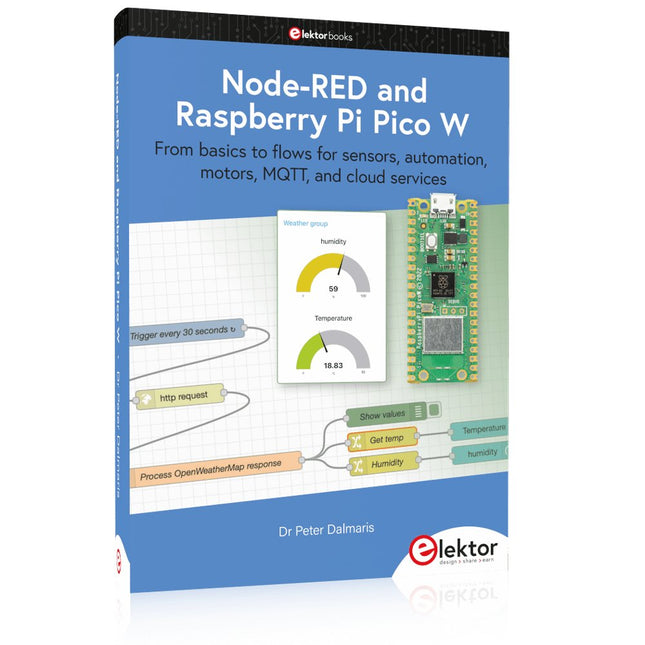
Elektor Publishing Node-RED and Raspberry Pi Pico W
From basics to flows for sensors, automation, motors, MQTT, and cloud services This book is a learning guide and a reference. Use it to learn Node-RED, Raspberry Pi Pico W, and MicroPython, and add these state-of-the-art tools to your technology toolkit. It will introduce you to virtual machines, Docker, and MySQL in support of IoT projects based on Node-RED and the Raspberry Pi Pico W. This book combines several elements into a platform that powers the development of modern Internet of Things applications. These elements are a flow-based server, a WiFi-enabled microcontroller, a high-level programming language, and a deployment technology. Combining these elements gives you the tools you need to create automation systems at any scale. From home automation to industrial automation, this book will help you get started. Node-RED is an open-source flow-based development tool that makes it easy to wire together devices, APIs, and online services. Drag and drop nodes to create a flowchart that turns on your lights at sunset or sends you an email when a sensor detects movement. Raspberry Pi Pico W is a version of the Raspberry Pi Pico with added 802.11n Wi-Fi capability. It is an ideal device for physical computing tasks and an excellent match to the Node-RED. Quick book facts Project-based learning approach. Assumes no prior knowledge of flow-based programming tools. Learn to use essential infrastructure tools in your projects, such as virtual machines, Docker, MySQL and useful web APIs such as Google Sheets and OpenWeatherMap. Dozens of mini-projects supported by photographs, wiring schematics, and source code. Get these from the book GitHub repository. Step-by-step instructions on everything. All experiments are based on the Raspberry Pi Pico W. A Wi-Fi network is required for all projects. Hardware (including the Raspberry Pi Pico W) is available as a kit. Downloads GitHub
€ 49,95
Leden € 44,96
-
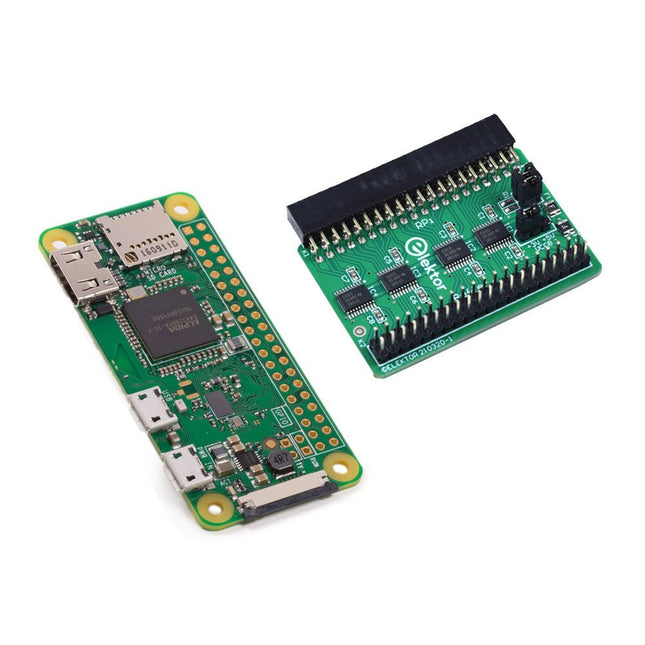
Elektor Bundles Raspberry Pi Bundel: Zero W + Buffer Board
Deze bundel bevat de Raspberry Pi Zero W en het Elektor Raspberry Pi Buffer Board. Raspberry Pi Zero W De Raspberry Pi Zero W is de nieuwste telg van de Raspberry Pi Zero-familie. De Raspberry Pi Zero W heeft alle functionaliteit van de originele Raspberry Pi Zero, maar wordt geleverd met toegevoegde connectiviteit bestaande uit: 802.11 b/g/n WLAN Bluetooth 4.1 Bluetooth Low Energy (BLE) Overige kenmerken 1 GHz, single-core CPU 512 MB RAM Mini HDMI en USB On-The-Go poorten Micro-USB voeding HAT-compatibele 40-pins header Composiet video en reset headers CSI-camera-aansluiting Downloads Mechanische tekening Schema's Elektor Raspberry Pi Buffer Board When you experiment with the Raspberry Pi on a regular basis and you connect a variety of external hardware to the GPIO port via the header you may well have caused some damage in the past. The Raspberry Pi Buffer Board is there to prevent this! The board is compatible with Raspberry Pi Zero, 3, 4, 5 and 400. All 26 GPIOs are buffered with bi-directional voltage translators to protect the Raspberry Pi when experimenting with new circuits. The PCB is intended to be inserted in the back of Raspberry Pi< 400. The connector to connect to the Raspberry Pi is a right angled 40-way receptacle (2x20). The PCB is only a fraction wider. A 40-way flat cable with appropriate 2x20 headers can be connected to the buffer output header to experiment for instance with a circuit on a breadboard or PCB. The circuit uses four TXS0108E ICs by Texas Instruments. The PCB can also be put upright on a Raspberry Pi 3 or newer. Downloads Schematics Layout
€ 52,95€ 44,95
Leden identiek
-
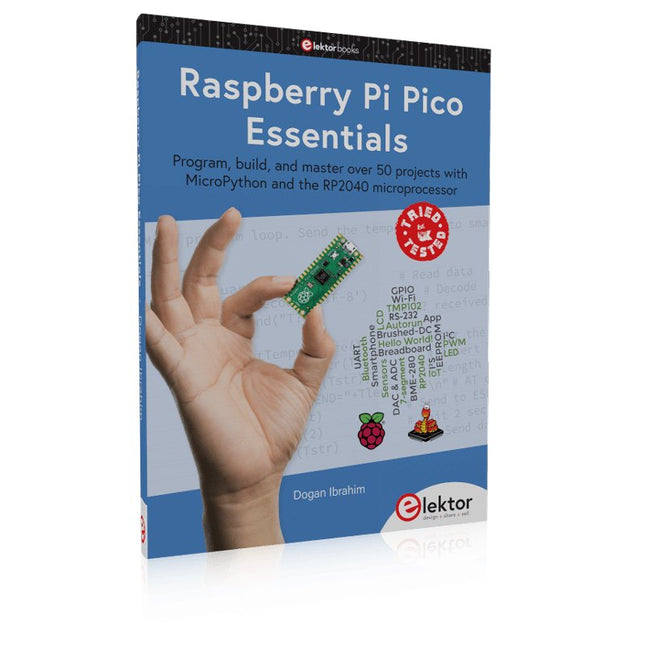
Elektor Publishing Raspberry Pi Pico Essentials
De Raspberry Pi Pico is een krachtige microcontrollermodule die speciaal ontworpen is voor fysiek computergebruik. Microcontrollers verschillen van single-board computers, zoals de Raspberry Pi 4, doordat ze geen besturingssysteem hebben. De Raspberry Pi Pico kan geprogrammeerd worden om een enkele taak zeer efficiënt uit te voeren binnen real-time regel- en besturingstoepassingen die snelheid vereisen. De 'Pico', zoals we hem noemen, is gebaseerd op de snelle, efficiënte en goedkope dual-core ARM Cortex-M0+ RP2040 microcontroller chip die tot 133 MHz werkt en beschikt over 264 KB SRAM, en 2 MB Flash geheugen. Behalve het grote geheugen heeft de Pico nog meer aantrekkelijke eigenschappen, waaronder een groot aantal GPIO pinnen, en populaire interface modules zoals ADC, SPI, I²C, UART, en PWM. Als klap op de vuurpijl biedt de chip snelle en nauwkeurige timing modules, een hardware debug interface, en een interne temperatuursensor.De Raspberry Pi Pico is gemakkelijk te programmeren met populaire talen op hoog niveau, zoals MicroPython en of C/C++. Dit boek is een inleiding tot het gebruik van de Raspberry Pi Pico microcontroller in combinatie met de programmeertaal MicroPython. De Thonny ontwikkelomgeving (IDE) wordt in alle beschreven projecten gebruikt. Er staan meer dan 50 werkende en geteste projecten in het boek, die de volgende onderwerpen behandelen: MicroPython installeren op Raspberry Pi Pico met behulp van een Raspberry Pi of een PC Timer interrupts en externe interrupts Analoog/Digitaal Converter (ADC) projecten Gebruik van de interne temperatuursensor en externe temperatuursensor chips Datalogging projecten PWM, UART, I²C, en SPI projecten Wi-Fi en apps gebruiken om met smartphones te communiceren Bluetooth en apps gebruiken om met smartphones te communiceren Digitaal/Analoog Converter (DAC) projecten Alle projecten die in het boek vermeld worden zijn volledig getest en werken. Alleen basis ervaring met programmeren en elektronica is nodig om de projecten te volgen. Voor alle beschreven projecten worden korte beschrijvingen, blokschema's, gedetailleerde schakelschema's, en volledige MicroPython programma-overzichten gegeven. Lezers kunnen de programma-overzichten vinden op de Elektor webpagina die ter ondersteuning van het boek werd gemaakt.
€ 39,95
Leden € 35,96
-
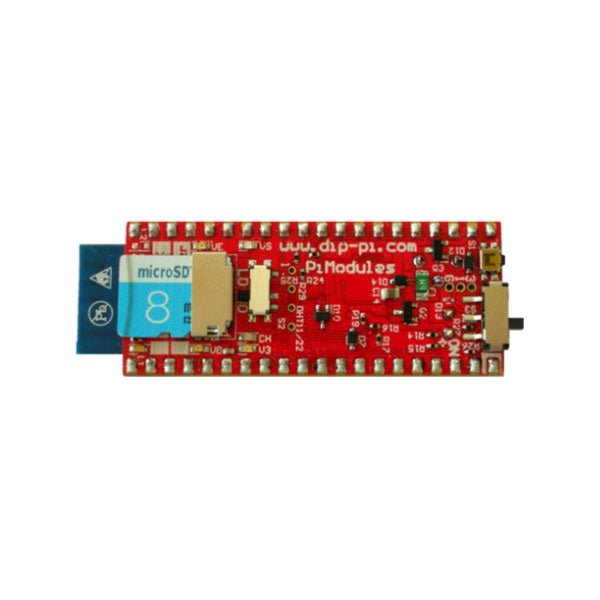
Pi Modules DiP-Pi Pico PIoT for Raspberry Pi Pico
The DiP-Pi PIoT is an Advanced Powered, WiFi connectivity System with sensors embedded interfaces that cover most of possible needs for IoT application based on Raspberry Pi Pico. It can supply the system with up to 1.5 A @ 4.8 V delivered from 6-18 VDC on various powering schemes like Cars, Industrial plant etc., additionally to original micro-USB of the Raspberry Pi Pico. It supports LiPo or Li-Ion Battery with Automatic Charger as also automatic switching from cable powering to battery powering or reverse (UPS functionality) when cable powering lost. Extended Powering Source (EPR) is protected with PPTC Resettable fuse, Reverse Polarity, as also ESD.The DiP-Pi PIoT contains Raspberry Pi Pico embedded RESET button as also ON/OFF Slide Switch that is acting on all powering sources (USB, EPR or Battery). User can monitor (via Raspberry Pi Pico A/D pins) battery level and EPR Level with PICO’s A/D converters. Both A/D inputs are bridged with 0402 resistors (0 OHM) therefore if for any reason user needs to use those Pico pins for their own application can be easy removed. The charger is automatically charging connected battery (if used) but in addition user can switch charger ON/OFF if their application needs it.DiP-Pi PIoT can be used for cable powered IoT systems, but also for pure Battery Powered System with ON/OFF. Each powering source status is indicated by separate informative LEDs (VBUS, VSYS, VEPR, CHGR, V3V3).User can use any capacity of LiPo or Li-Ion type; however, must take care to use PCB protected batteries with max discharge current allowed of 2 A. The embedded battery charger is set to charge battery with 240 mA current. This current is set by resistor so if user need more/less can himself to change it. The DiP-Pi PIoT is also equipped with WiFi ESP8266 Clone module with embedded antenna. This feature open a wide range of IoT applications based on it.In Addition to all above features DiP-Pi PIoT is equipped with embedded 1-wire, DHT11/22 sensors, and micro–SD Card interfaces. Combination of the extended powering, battery, and sensors interfaces make the DiP-Pi PIoT ideal for IoT applications like data logger, plants monitoring, refrigerators monitoring etc.DiP-Pi PIoT is supported with plenty of ready to use examples written in Micro Python or C/C++.SpecificationsGeneral Dimensions 21 x 51 mm Raspberry Pi Pico pinout compatible Independent Informative LEDs (VBUS, VSYS, VEPR, CHGR, V3V3) Raspberry Pi Pico RESET Button ON/OFF Slide Switch acting on all powering sources (USB, EPR, Battery) External Powering 6-18 VDC (Cars, Industrial Applications etc.) External Power (6-18 VDC) Level Monitoring Battery Level Monitoring Inverse Polarity Protection PPTC Fuse Protection ESD Protection Automatic Battery Charger (for PCB protected LiPo, Li-Ion – 2 A Max) Automatic/User Control Automatic Switch from Cable Powering to Battery Powering and reverse (UPS Functionality) Various powering schemes can be used at the same time with USB Powering, External Powering and Battery Powering 1.5 A @ 4.8 V Buck Converter on EPR Embedded 3.3 V @ 600 mA LDO ESP8266 Clone WiFi Connectivity ESP8266 Firmware Upload Switch Embedded 1-wire Interface Embedded DHT-11/22 Interface Powering Options Raspberry Pi Pico micro-USB (via VBUS) External Powering 6-18 V (via dedicated Socket – 3.4/1.3 mm) External Battery Supported Battery Types LiPo with protection PCB max current 2A Li-Ion with protection PCB max current 2A Embedded Peripherals and Interfaces Embedded 1-wire interface Embedded DHT-11/22 Interface Micro SD Card Socket Programmer Interface Standard Raspberry Pi Pico C/C++ Standard Raspberry Pi Pico Micro Python Case CompatibilityDiP-Pi Plexi-Cut CaseSystem Monitoring Battery Level via Raspberry Pi Pico ADC0 (GP26) EPR Level via Raspberry Pi Pico ADC1 (GP27) Informative LEDs VB (VUSB) VS (VSYS) VE (VEPR) CH (VCHR) V3 (V3V3) System Protection Direct Raspberry Pi Pico Hardware Reset Button ESD Protection on EPR Reverse Polarity Protection on EPR PPTC 500 mA @ 18 V fuse on EPR EPR/LDO Over Temperature protection EPR/LDO Over Current protection System Design Designed and Simulated with PDA Analyzer with one of the most advanced CAD/CAM Tools – Altium Designer Industrial Originated PCB Construction 2 ozcopper PCB manufactured for proper high current supply and cooling 6 mils track/6 mils gap technology 2 layers PCB PCB Surface Finishing – Immersion Gold Multi-layer Copper Thermal Pipes for increased System Thermal Response and better passive cooling Downloads Datasheet Manual
€ 21,95€ 14,95
Leden identiek











